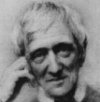
Principle 1. Factual InspirationThe true nature of Sacred Scripture cannot be determined from arguments of convenience. It can only be learnt from observing God's factual way of inspiration.
|
Interpreting Scripture
Correctly
|
||
An example from biologyNowadays we are conscious of the bacteria that surround us. We know that many of the diseases that threaten us, from the ordinary whooping cough to plague and typhoid fever, are caused by them. Bacteria have now been classified. We know what they look like, what they eat, how they spread and multiply. It is this acquaintance with their habits and weaknesses that allows us to fight them. Our hygienic measures, our cooking prescription, our preventive and curative medicines are guided by this knowledge. But to know what bacteria are like we had to actually see them and study them. In fact, it is only relatively recently that bacteria were discovered. In 1590 the Dutch spectacle-maker Zacharias Janssen found that a series of lenses arranged in a certain order could magnify objects considerably. He invented the first compound microscope. Two hundred years later better glass making led to improving the microscope to such an extent that scholars such as Louis Pasteur and Robert Koch could discover the role played by germs in disease. In fact, bacteria cannot be seen with the naked eye: it is to the microscope that we owe our familiarity with them. Some kind of bacteria are so small that we need to put a million of them on a line to form one centimeter. But even those we can see with the modern electronic microscope which magnifies objects up to two million times their original size! Modern science rests on observation. It is obvious that it is no use building castles in the air imagining what we would wish bacteria to be like! It is no use drawing conclusions without having first observed and gathered the facts. Science requires humility: the readiness to observe. |
|
||
IncarnationThe same holds good in the field of revealed truth. God sent his only begotten Son to become human in Palestine. But how was this done?
All these are facts. Speculations as to in what country or during what period of world history this redeemer should or could have been born, what languages he should or could have made his mother tongue, what jobs he should or could have chosen, have no meaning. Believers must begin with an acknowledgement of these facts of the incarnation. Faith too requires humility. |
|||
Case study: Jesus curses a fig treeBegin by looking at this video (click on start arrow):
This parable is linked to an incident, recounted in the Gospels, that is full of surprises:
To get to know the nature of Scripture, please examine this case study very carefully: Jesus curses a fig tree. After completing the case study, return to this lesson. |
|||
Exercise: Jesus' eucharistic wordsAmong the most important words Jesus' spoke in his life are the words by which he instituted the Eucharist. But New Testament texts do not agree in their exact wording. When, at the Last Supper, Jesus took the cup, what did he say? Look at these variations:
Compare the four formulations and try to work out the answer to the following questions (before clicking on the explanatory text):
|
|||
InspirationWe may not argue beforehand: God cannot inspire in this or that way, God could never convey his message in this or that kind of book . . . The only correct attitude is to observe the facts of inspiration, to learn in humility and reflect on the implications.
Let us first learn to watch and to listen. Let us give God a chance to show how God decided to inspire the sacred books. Arguments of "God could not", "God should not" or "God may not" cannot be tolerated. What did God actually do ? That is the question that needs to be answered, or rather: it is the fact we have to establish. All other questions may only be put after and in relation to this one! "For my ways are far above your ways, says the Lord". John Wijngaards |
|||
|
Go to the next
lesson: We must know what the human author wanted to say. |
course overview | ||
CreditsThe texts in our course Interpreting Scripture Correctly were written by John Wijngaards in 2009. Part of the contents is based on his earlier publications, in particular:
Illustrations in the video clip by Jackie Clackson. |
 |
 |
 |
 |
 |
|
|---|---|---|---|---|---|
| Facts |
 |
 |
 |
 |
|||